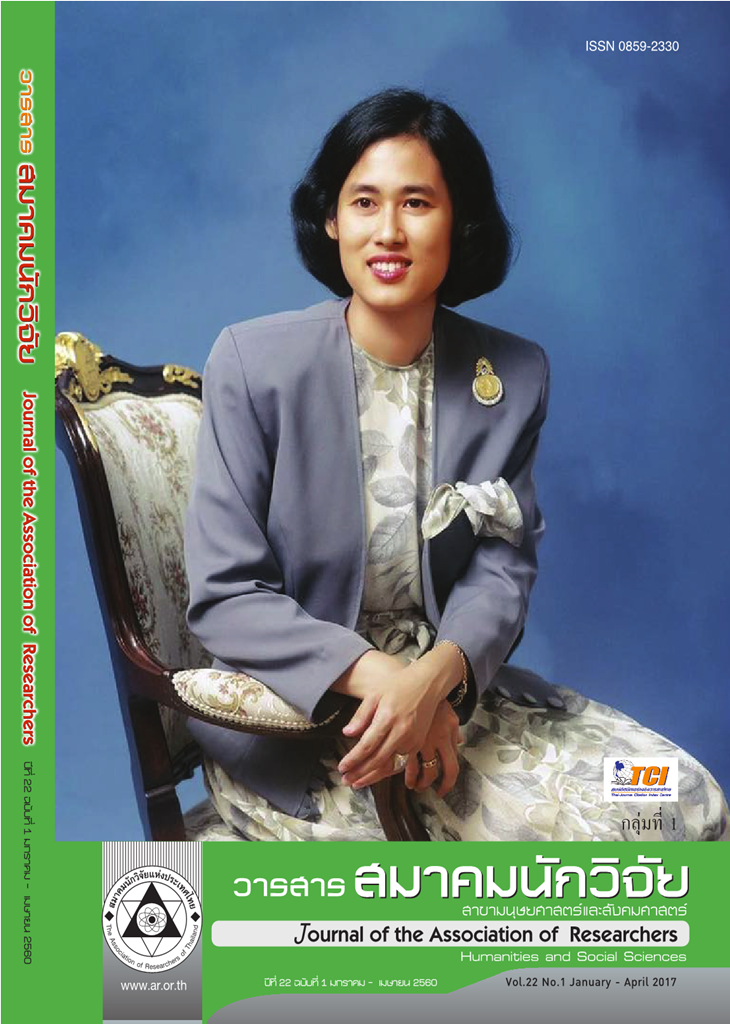Purchase Behavior and Opportunities of Buying Clothes and Shoes for the Elderly Customer in Thailand
Main Article Content
Abstract
This research aimed (1) to survey the aged customers' needs and behaviors on buying clothes,shoes in Thailand, 2) to analyze the aged personal factors which result the opportunities of buying clothes, shoes, and 3) to analyze the customers' needs and buying behaviors which result the opportunities of buying clothes, shoes in Thailand. This research was quantitative research, testing 580 samples of Thai elderly customers by using multistage sampling techniques. The data were collected by questionnaires. The statistics used in the research were descriptive statistics and the multinomial logistic regression; used to test the hypothesis. The research findings were; (1) the highest rate of aging groups' needs was casual clothes, secondly was working out fits which mainly must be worn comfortably, easily kept with modern design. The affordable price per head ranged from 500-1,000 Baht. Most of them bought clothes from the department stores.The clothes brands were not specified. The considered choices of buying shoes were comfortability. Shoes for health were the top priority. Wearing shoes conveniently and comfortably. The price per a pair was from 1,001 - 1,500 Baht. Mostly, they bought shoes from department stores and the brands were selective. (2) the personal factors of gender, educational background, income, income resources affect their choices of buying the outfits used for
working, casual clothes, and comfortable shoes for health. (3) Their needs and the reasons of purchasing behavior were for their good health. The frequency of buying affect the opportunity of buying working clothes. As well as TV media, sales people, the reasons of purchase and the frequency of buying affect
the opportunity of buying casual clothes. Price, reference groups and shoe sources sale affect their shoe choices for health. Media, Price and frequency of buying affect shoe brand selecting chosen bythe aging in Thailand.
Article Details
บทความที่ปรากฏในวารสารนี้ เป็นความรับผิดชอบของผู้เขียน ซึ่งสมาคมนักวิจัยไม่จำเป็นต้องเห็นด้วยเสมอไป การนำเสนอผลงานวิจัยและบทความในวารสารนี้ไปเผยแพร่สามารถกระทำได้ โดยระบุแหล่งอ้างอิงจาก "วารสารสมาคมนักวิจัย"
References
กิ่งไผ่ เพชรกาฬ และ พิจัย นิรมาสกุล. (2557). ภาพลักษณ์รองเท้าแบรนด์ Fitflop และพฤติกรรมการเลือกซื้อรองเท้าเพื่อสุขภาพในเขตกรุงเทพมหานคร. สืบค้นจากwww.amsarthailand.utcc.ac.th/attachments/article/32/Kingpai.pdf
ชมพูนุท เกี่ยวกิ่งแก้ว และ วิโรจน์ เจษฎาลักษณ์.(2557). ความสัมพันธ์ระหว่างการให้ความสำคัญกับความเคลื่อนไหวแฟชั่นและความพึงพอใจในกลยุทธ์การตลาดเสื้อผ้าแฟชั่นของผู้บริโภค. วารสารการจัดการ คณะวิทยาการจัดการมหาวิทยาลัยราชภัฎลำปาง. 2(7), 90-105.
ณัฐนันท์ มิมะพันธุ์. (2556). ทัศนคติและพฤติกรรมการเลือกซื้อเสื้อผ้าบนเว็บไซต์เฟชบุ๊กของประชาชนในกรุงเทพมหานคร.สืบค้นจาก www.spu.ac.th/commarts/files/2013/9
นริสรา พึ่งโพธิ์สภ และ ฐาศุกร์ จันประเสริฐ. (2557). ปัจจัยด้านจิตสังคมที่เกี่ยวข้องกับคุณภาพชีวิตของผู้สูงอายุ: การสังเคราะห์งานวิจัยด้วยการวิเคราะห์อภิมาน. วารสารพฤติกรรมศาสตร์, 20(1), 35-52.
พงษ์ศักดิ์ อัสสกุล. (2557). บทสัมภาษณ์ประธานสหพันธุ์อุตสาหกรรมสิ่งทอไทยและนายกสมาคมอุตสาหกรรมสิ่งทอไทย,หนังสือพิมพ์กรุงเทพธุรกิจ, ฉบับวันที่ 17 ตุลาคม 2557, หน้า 2.
ยุทธ ไกรวรรณ์ และ กุสุมา ผลาพรม. (2553). พื้นฐานการวิจัย. กรุงเทพฯ: ศูนย์สื่อเสริมวราภรณ์ ลิ้มเปรมวัฒนา และ อนุสรณ์จันดาแสง. (2558). การวิเคราะห์องค์ประกอบปัจจัยที่มีผลต่อพฤติกรรมการใช้จ่ายของผู้สูงอายุในเขตกรุงเทพมหานคร. วารสารวิชาการ สมาคมสถาบันอุดมศึกษาเอกชนแห่งประเทศไทย, 21(1),179-188.
ศิริชัย กาญจนวาสี, ทวีวัฒน์ ปิตยานนท์ และดิเรก ศรีสุโข. (2551). การเลือกใช้สถิติที่เหมาะสมสำหรับการวิจัย, (พิมพ์ครั้งที่ 5.กรุงเทพฯ: บุญศิริการพิมพ์.
ศูนย์เทคโนโลยีสารสนเทศและการสื่อสาร. (2557). ประชากรสูงอายุไทย: ปัจจุบันและอนาคต เอกสารประมวลสถิติด้านสังคม 1/2558. กรุงเทพฯ: สำนักงานปลัดกระทรวงการพัฒนาสังคมและความมั่นคงของมนุษย์.
สำนักงานคณะกรรมการพัฒนาการเศรษฐกิจและสังคมแห่งชาติ. (2558). แผนพัฒนาเศรษฐกิจและสังคมแห่งชาติ ฉบับที่ 12. กรุงเทพฯ: ผู้แต่ง.
References
Assakul, P. (2014). Interview report of The Chairman, The Federation of Thai Textile Industries, The Thai Textile Manufacturing Association. Bangkokbiznews, 10/17/2014. p.2 (in Thai).
Eastman, T. K. & Iyer, R. (2004). The elderly’s uses and attitudes towards the internet. Journal of consumer marketing, 21(3), 208-220.
Griwan, Y. & Parapom, K. (2010). The Basic of Research. Bangkok: Optional Media Center. (in Thai).
Information Technology and Communication Centre.(2557). Thai Aging population: today and tomorrow,Social Statistics Document 1/2015. Bangkok: Office of the Permanent Secretary, Ministry of Social Development and Human Security. (in Thai)
Kanjanavasri, S., Petayanon, T., & Srisuko, D. (2008). Statistics for Research. (5th ed.) Bangkok: Boonsiri Printing. (in Thai)
Kaylene, C. W. & Robert, A. P. (2011). Marketing to the Generations. Journal of Behavioral Studies inBusiness. (3) (Apr 2011), 1-17.
Kilkikal, C. & Jasadarak, V. (2014). The importance of fashion trends and satisfaction in fashion marketing strategies of consumers. Management Journal: Lampang Rajabhat University. 2(7), 90-105. (in Thai).
Kotler, P. (2000). Marketing management (10th ed). New Jersy: Prentice Hall.
Kotler, P. & Armstrong, G. (2014). Principles of marketing (15thed). New Jersey: Pearson International.
Kotler, P. & Keller, K. L. (2015). Marketing management, (15thed). New Jersey: Pearson International.
Laivechpittaya, T. & Udomkit, N. (2013). A matter of shoes: The analysis of desired attributes of shoes and Its retail shops from Bangkok consumers’ perspectives. International Journal of Marketing Studies. 5(2), 33-40.
Lekpollaakarn, A. & Khemarangsan, A. (2015). “A study of thai Consumers Behavior towards fashion clothing” International Business Program, Silpakorn University International College. Retrived From www.suic.org/wp-content/uploads/247Apawan.pdf.
Limpramwatana, V. & Jundasang, A. (2015). Factor Analysis of Spending Behavior of Elderly in Bangkok.Academic Journal, Association of Private Higher Education Institutions of Thailand, 21(1), 179-188. (in Thai).
Mimapun, N. (2013). Attitude and purchasing behavior of apparel on facebook webpages of users in Bangkok. Retreived from www.spu.ac.th/commarts/files/2013/9. (in Thai).
Office of the Nation Economic and Social Development Board. (2015). The Nation Economic and Social Development Plan (edition 12). Bangkok: Office of the Nation Economic and Social Development Board. (in Thai).
Petkan, k. & Niramansakul, P. (2014). Image of Fitflop shoes brand and behavior of selecting shoes for health of consumer in Bangkok areas. Retreived from ww.amsarthailand.utcc.ac.th/attachments/article/32/Kingpai.pdf. (in Thai).
Pungposop, N. & Junprasert, T. (2014). Factors correlating with Quality of Life among Thai Elderly:Research Synthesis by Meta-Analysis. Journal of Behavioral Science, 20(1), 35-52. (in Thai).
San, Y. W. & Yazdanifard, R. (2014). Howcustomer decision making processdiffer from youngster toolderconsumer generation. Journal of Researchin Marketing. 2(2), 151-156.
Schiffman, L. G. & Kanuk, L. L. (2010). Customer behavior (10th ed). New Jersey: Prentice Hall.
Thomas, J. B. & Peters, C. L. O. (2009). Silver seniors Exploring the self-concept, lifestyles, and Apparel consumption of women over age 65. International Journal of retail & distribution management,37(12), 1018-1040.
Tong, D. Y. K & Lai, K. P. (2012). Ladies’purchase intension during retail shoes sales promotions.International Journal of retail & distribution management, 40(2), 90-108.
Vanichbuncha, K. (2008). Mutlivariate analysis: SPSS for Windows. (6th ed.). Bangkok: Chulalongkorn University Press. (in Thai).
Zeb, H., Rashid, K. & Javeed, M. B. (2011). Influence of brands on female consumer's buying behavior in Pakistan. International Journal of Trade, Economics and Finance. 2(3), 225-231.


